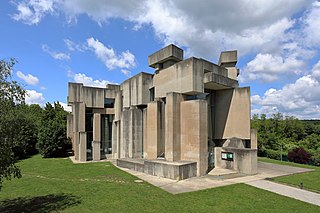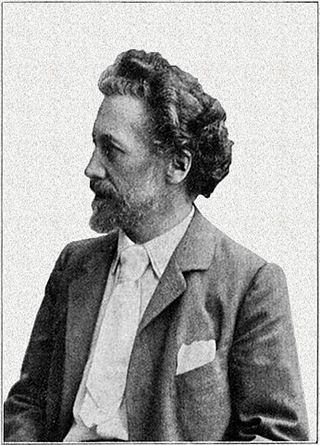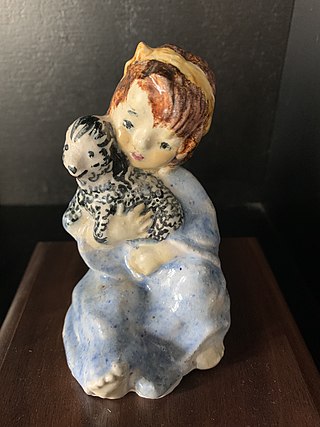
Josef Lorenzl (1 September 1892 – 15 August 1950) was an Austrian sculptor and ceramicist of the Art Deco period, the same era as Ferdinand Preiss (1882–1943) and Demetre Chiparus (1886–1947). [1]

Josef Lorenzl (1 September 1892 – 15 August 1950) was an Austrian sculptor and ceramicist of the Art Deco period, the same era as Ferdinand Preiss (1882–1943) and Demetre Chiparus (1886–1947). [1]
Lorenzl was born on 1 September 1882 in Vienna, Austria and died there on 15 August 1950. Little is known about his early years, but more is known about his later life. Lorenzl started his career working at a foundry at the Vienna Arsenal where he learned the techniques of bronze casting. The Vienna Arsenal was a military storage complex located in the south-eastern part of Vienna. [1]
While at the Vienna Arsenal, Lorenzl produced many bronze and chryselephantine sculptures, the latter using both bronze and ivory, and captivated by the female form he became famed for his shapely dancing girls with long, elegant legs and closed eyes. These pieces of his were signed "Enzl", "Lor", "R. Lor", "Renz" or "Renzl". [2] Occasionally the name "Crejo" appears on his pieces, Crejo having been a painter and one of Lorenzl's friends, and who sometimes applied colour to the pieces. These joint works are sought-after items. [1] The large majority of Lorenzl's figurines were attached to Brazilian green onyx plinths. [2]
Lorenzl's talents also extended to being a gifted ceramicist. He produced pieces for Goldscheider, working from a studio on company grounds. As with his chryselephantine pieces, his ceramic works were in great demand and became the embodiment of the Art Déco period. Famous amongst these is "The Butterfly Girl" after the famous dancer Niddy Impekoven from the 1920s. [3] Lorenzl also worked for two other Viennese firms, Porzellanfabrik Hertwig & Co. and Keramos Porcelain. [4]
'Keramos' or 'Wiener Kunst-Keramik und Porzellan Manufaktur AG' was founded in 1910 by several disabled war veterans, subsidised by Austria and later became a public company, directed by Otto Köller, and Rudof and Heinrich Wolf. It was located in Schwarze Adlerstiege, while the factory operated from 17 Schleiergasse. [1]
After Lorenzl's death on 15 August 1950, his wife Anna (Njura) Lorenzl, destroyed a large number of his figurines. [5]

Goldscheider Porcelain Manufactory and Majolica Factory was an Austrian ceramic manufactory.

Chryselephantine sculpture is sculpture made with gold and ivory. Chryselephantine cult statues enjoyed high status in Ancient Greece.

Fritz Wotruba was an Austrian sculptor of Czecho-Hungarian descent. He was considered one of the most notable sculptors of the 20th century in Austria. In his work, he increasingly dissolves figurative components in favor of geometrical abstraction with the shape of the cube as the basic form.
Demétre Haralamb Chiparus was a Romanian Art Deco era sculptor who lived and worked in Paris, France. He was one of the most important sculptors of the Art Deco era.

Johann Philipp Ferdinand Preiss was a German sculptor. He was one of the leading sculptors of the Art Deco period.

The Museum für Kunst und Gewerbe Hamburg is a museum of fine, applied and decorative arts in Hamburg, Germany. It is located centrally, near the Hauptbahnhof.
Stefan Dakon (1904–1992) was an Austrian artist who worked in close association with Josef Lorenzl, producing many exciting bronze figurine sculptures of the Art Deco period. Dakon's models were used among others by members of the association of bronze producers "Wiener Bronzen", as well as by the famous ceramics manufacturer Goldscheider from Vienna. He also designed models for the Austrian ceramics manufacturer Keramos.

Edmund Ritter von Hellmer, born Edmund Hellmer and ennobled in 1912, was an Austrian sculptor who worked in the styles of Historicism and Art Nouveau.

Julius Alwin Franz Georg Andreas Ritter von Schlosser was an Austrian art historian and an important member of the Vienna School of Art History. According to Ernst Gombrich, he was "One of the most distinguished personalities of art history".
Walter Bosse was a Viennese artist, designer, ceramist, potter, metalworker, and craftsman noted for his modernist bronze animal figurines and grotesques.

Bruno Zach was an Austrian art deco sculptor of Ukrainian birth who worked in the early-to-mid 20th century. His output included a wide repertoire of genre subjects, however he is best known for his erotic sculptures of young women.
Werkstätte Hagenauer Wien - (wHw) - was a family business in Vienna that produced fine, handcrafted objects for decoration and use over its nearly ninety-year history. The workshop closed in 1987 but the company's retail premises, opened in 1938 on Vienna's Opernring, survives today as a museum and shop.
Julius Paul Schmidt-Felling (1835–1920) was a German sculptor who worked during the mid-to-late 19th century and early 20th century. The subject matter of his work was wide and varied. He produced, among others, bronze statues of heroic warriors, athletes, blacksmiths, and farmers. A number of his sculptures of young children were in the Dutch colonial style, some being whimsical in nature.

Claire Jeanne Roberte Colinet (1880–1950) was a French sculptor of Belgian birth who worked during the early-to-mid 20th century. The subject matter of her best known work was primarily Arab female dancers. The majority of her career output in sculpture can be classified as being of the Art Deco style.

Otto Schmidt-Hofer (1873–1925) was a German sculptor who worked during the late 19th century and early 20th century. His work was primarily Neoclassical and Art Nouveau between 1893-1914 and Art Deco from 1915 until his death in 1925.
Paul Philippe (1870–1930) was a French sculptor who worked during the late 19th and early 20th century. His work primarily consisted of bronze sculptures done in the Art Nouveau and Art Deco genres.

Susi Singer, also known as Selma Singer-Schinnerl, was an Austrian-American Jewish ceramic artist known for her bright and detailed figurines.

Valerie "Vally" Wieselthier was an Austrian-American ceramic artist.

Helmut Leherb was an Austrian artist and representative of the Vienna School of Fantastic Realism, which is close to Surrealism. He was born Helmut Leherbauer in Vienna and is also known as Maître Leherb.

Ena Rottenberg was a Hungarian-Austrian craftswoman, draftswoman, ceramist and member of the artists' community of the Wiener Werkstätte.